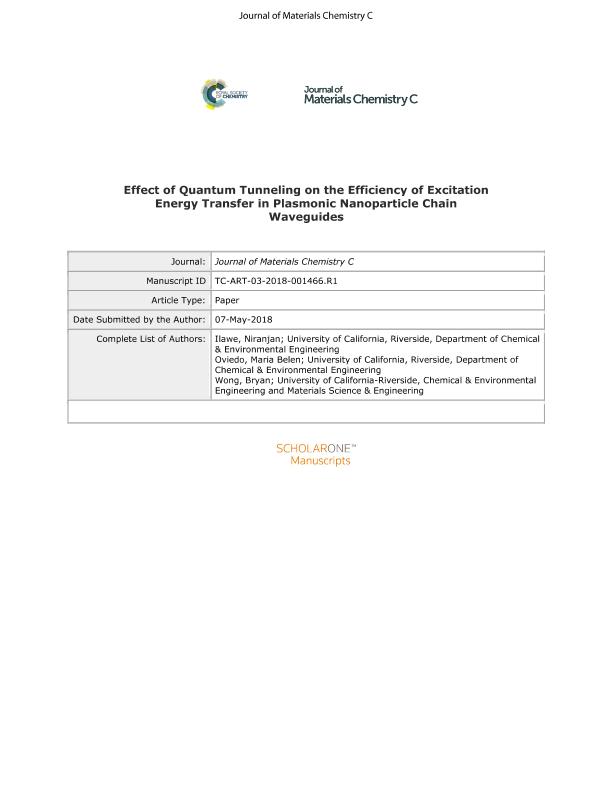Mostrar el registro sencillo del ítem
dc.contributor.author
Ilawe, Niranjan V.
dc.contributor.author
Oviedo, María Belén

dc.contributor.author
Wong, Bryan M.
dc.date.available
2019-11-28T17:03:23Z
dc.date.issued
2018-05
dc.identifier.citation
Ilawe, Niranjan V.; Oviedo, María Belén; Wong, Bryan M.; Effect of quantum tunneling on the efficiency of excitation energy transfer in plasmonic nanoparticle chain waveguides; Royal Society of Chemistry; Journal of Materials Chemistry C; 6; 22; 5-2018; 5857-5864
dc.identifier.issn
2050-7526
dc.identifier.uri
http://hdl.handle.net/11336/90785
dc.description.abstract
We present a detailed analysis of the electronic couplings that mediate excitation energy transfer (EET) in plasmonic nanoantenna systems using large-scale quantum dynamical calculations. To capture the intricate electronic interactions in these large systems, we utilize a real-time, time-dependent, density functional tight binding (RT-TDDFTB) approach to characterize the quantum-mechanical efficiency of EET in plasmonic nanoparticle chains with subnanometer interparticle spacings. In contrast to classical electrodynamics methods, our quantum dynamical calculations do not predict a monotonic increase in EET efficiency with a decrease in interparticle spacing between the nanoparticles of the nanoantenna. Most notably, we show a sudden drop in EET efficiencies as the interparticle distance approaches subnanometer length scales within the nanoparticle chain. We attribute this drop in EET efficiency to the onset of quantum charge tunneling between the nanoparticles of the chain which, in turn, changes the nature of the electronic couplings between them. We further characterize this abrupt change in EET efficiency through visualizations of both the spatial and time-dependent charge distributions within the nanoantenna, which provide an intuitive classification of the various types of electronic excitations in these plasmonic systems. Finally, while the use of classical electrodynamics methods have long been used to characterize complex plasmonic systems, our findings demonstrate that quantum-mechanical effects can result in qualitatively different (and sometimes completely opposite) results that are essential for accurately calculating EET mechanisms and efficiencies in these systems.
dc.format
application/pdf
dc.language.iso
eng
dc.publisher
Royal Society of Chemistry
dc.rights
info:eu-repo/semantics/openAccess
dc.rights.uri
https://creativecommons.org/licenses/by-nc-sa/2.5/ar/
dc.subject
ENERGY TRANSFER
dc.subject
PLASMON
dc.subject
QUANTUM DYNAMICS
dc.subject.classification
Física Atómica, Molecular y Química

dc.subject.classification
Ciencias Físicas

dc.subject.classification
CIENCIAS NATURALES Y EXACTAS

dc.title
Effect of quantum tunneling on the efficiency of excitation energy transfer in plasmonic nanoparticle chain waveguides
dc.type
info:eu-repo/semantics/article
dc.type
info:ar-repo/semantics/artículo
dc.type
info:eu-repo/semantics/publishedVersion
dc.date.updated
2019-09-30T18:33:20Z
dc.journal.volume
6
dc.journal.number
22
dc.journal.pagination
5857-5864
dc.journal.pais
Reino Unido

dc.description.fil
Fil: Ilawe, Niranjan V.. University Of California Riverside; Estados Unidos
dc.description.fil
Fil: Oviedo, María Belén. Consejo Nacional de Investigaciones Científicas y Técnicas. Centro Científico Tecnológico Conicet - Córdoba. Instituto de Investigaciones en Físico-química de Córdoba. Universidad Nacional de Córdoba. Facultad de Ciencias Químicas. Instituto de Investigaciones en Físico-química de Córdoba; Argentina. Universidad Nacional de Córdoba. Facultad de Cs.químicas. Departamento de Química Teórica y Computacional; Argentina
dc.description.fil
Fil: Wong, Bryan M.. University Of California Riverside; Estados Unidos
dc.journal.title
Journal of Materials Chemistry C
dc.relation.alternativeid
info:eu-repo/semantics/altIdentifier/url/http://xlink.rsc.org/?DOI=C8TC01466C
dc.relation.alternativeid
info:eu-repo/semantics/altIdentifier/doi/http://dx.doi.org/10.1039/C8TC01466C
Archivos asociados
